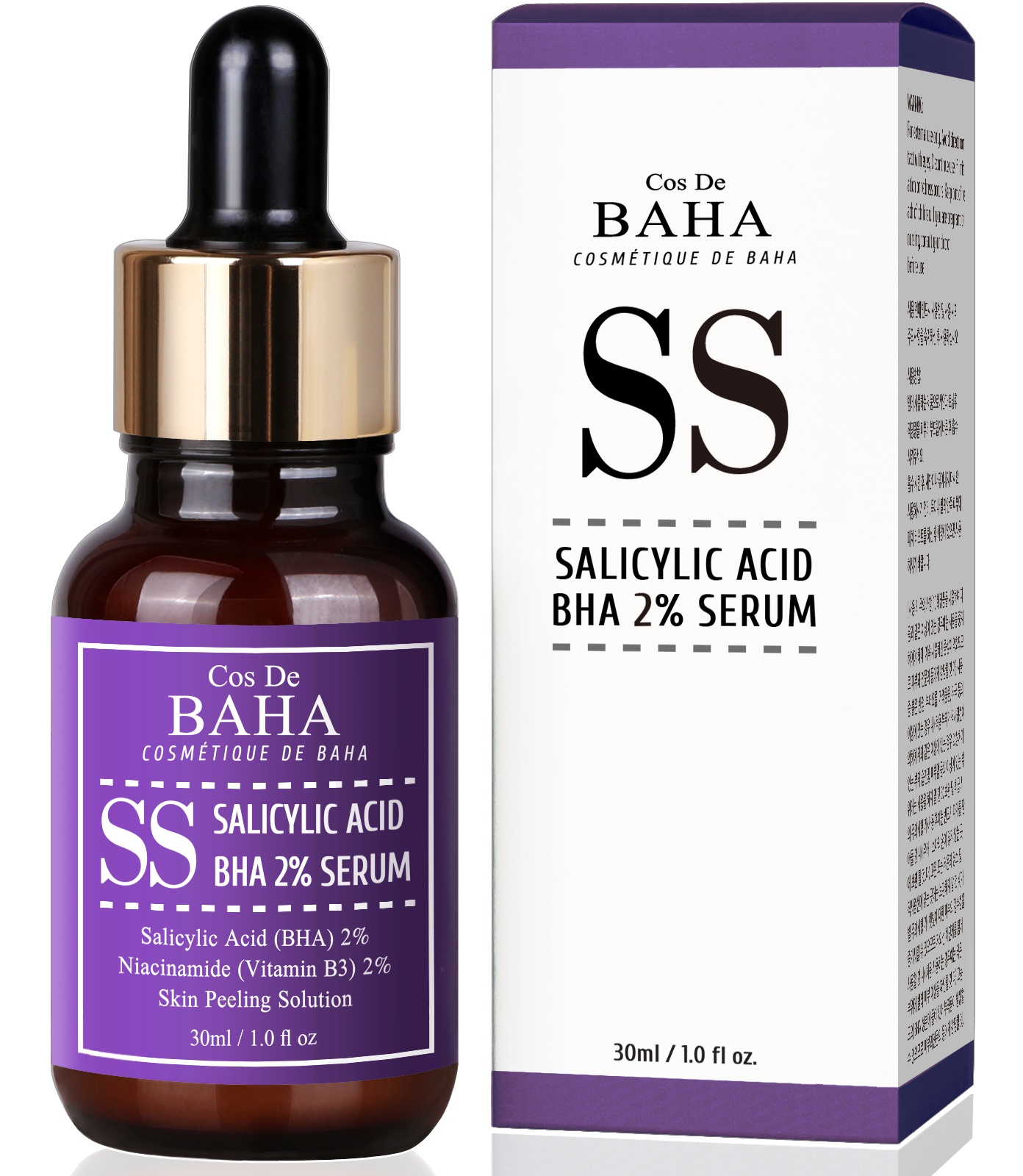
Highlights
Key Ingredients
Other Ingredients
Skim through
| Ingredient name | what-it-does | irr., com. | ID-Rating |
|---|---|---|---|
| *Aloe Barbadensis Leaf Extract | soothing, emollient, moisturizer/humectant | goodie | |
| Propanediol | solvent, moisturizer/humectant | ||
| Niacinamide | cell-communicating ingredient, skin brightening, anti-acne, moisturizer/humectant | superstar | |
| Salicylic Acid | exfoliant, anti-acne, soothing, preservative | superstar | |
| 1,2-Hexanediol | solvent | ||
| *Camellia Sinensis Leaf Extract | antioxidant, soothing | goodie | |
| *Leontopodium Alpinum Extract | |||
| *Momordica Charantia Fruit Extract | |||
| *Sambucus Nigra Flower Extract | soothing | ||
| Polysorbate 20 | emulsifying, surfactant/cleansing | 0, 0 | |
| Sodium Citrate | chelating, buffering | ||
| Hydroxyethylcellulose | viscosity controlling | ||
| Peat | soothing, antimicrobial/antibacterial | goodie |
Cos De BAHA Salicylic Acid BHA 2% SerumIngredients explained
The extract coming from the juice containing leaves of the Aloe vera plant. It's usually a hydroglycolic extract (though oil extract for the lipid parts also exists) that has similar moisturizing, emollient and anti-inflammatory properties as the juice itself. We have written some more about aloe here.
Propanediol is a natural alternative for the often used and often bad-mouthed propylene glycol. It's produced sustainably from corn sugar and it's Ecocert approved.
It's quite a multi-tasker: can be used to improve skin moisturization, as a solvent, to boost preservative efficacy or to influence the sensory properties of the end formula.
- A multi-functional skincare superstar with several proven benefits for the skin
- Great anti-aging, wrinkle smoothing ingredient used at 4-5% concentration
- Fades brown spots alone or in combination with amino sugar, acetyl glucosamine
- Increases ceramide synthesis that results in a stronger, healthier skin barrier and better skin hydration
- Can help to improve several skin conditions including acne, rosacea, and atopic dermatitis
- It's one of the gold standard ingredients for treating problem skin
- It can exfoliate skin both on the surface and in the pores
- It's a potent anti-inflammatory agent
- It's more effective for treating blackheads than acne
- For acne combine it with antibacterial agents like benzoyl peroxide or azelaic acid
A really multi-functional helper ingredient that can do several things in a skincare product: it can bring a soft and pleasant feel to the formula, it can act as a humectant and emollient, it can be a solvent for some other ingredients (for example it can help to stabilize perfumes in watery products) and it can also help to disperse pigments more evenly in makeup products. And that is still not all: it can also boost the antimicrobial activity of preservatives.
- Green tea is one of the most researched natural ingredients
- The active parts are called polyphenols, or more precisely catechins (EGCG being the most abundant and most active catechin)
- There can be huge quality differences between green tea extracts. The good ones contain 50-90% catechins (and often make the product brown and give it a distinctive smell)
- Green tea is proven to be a great antioxidant, UV protectant, anti-inflammatory, anticarcinogenic and antimicrobial
- Because of these awesome properties green tea is a great choice for anti-aging and also for skin diseases including rosacea, acne and atopic dermatitis



It's a common little helper ingredient that helps water and oil to mix together. Also, it can help to increase the solubility of some other ingredients in the formula.
A little helper ingredient that is used to adjust the pH of the product. It also helps to keep products stay nice longer by neutralizing the metal ions in the formula (they usually come from water).
A nice little helper ingredient that can thicken up cosmetic products and create beautiful gel formulas. It's derived from cellulose, the major component of the cell wall of green plants. It is compatible with most co-ingredients and gives a very good slip to the formulas.
A black, soil-like, nutrient-rich thing that has a complex composition with a bunch of potential therapeutic effects. It has long been used in physiotherapy, rheumatology and sports medicine.
As for skincare, peat has promising antimicrobial activity (thanks to its main components humic and fulvic acid), it's also a mild astringent, anti-inflammatory and even shows some UVB-protective effects. Thanks to these properties, peat has some promise as an adjacent treatment in inflammatory-related skin diseases like atopic dermatitis, psoriasis or rosacea.
You may also want to take a look at...
| what‑it‑does | soothing | emollient | moisturizer/humectant |
| what‑it‑does | solvent | moisturizer/humectant |
| what‑it‑does | cell-communicating ingredient | skin brightening | anti-acne | moisturizer/humectant |
| what‑it‑does | exfoliant | anti-acne | soothing | preservative |
| what‑it‑does | solvent |
| what‑it‑does | antioxidant | soothing |
| what‑it‑does | soothing |
| what‑it‑does | emulsifying | surfactant/cleansing |
| irritancy, com. | 0, 0 |
| what‑it‑does | chelating | buffering |
| what‑it‑does | viscosity controlling |
| what‑it‑does | soothing | antimicrobial/antibacterial |






